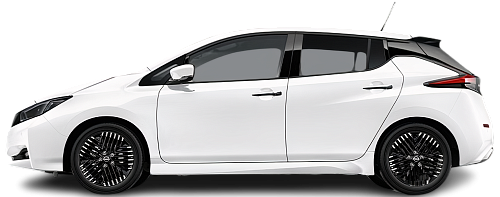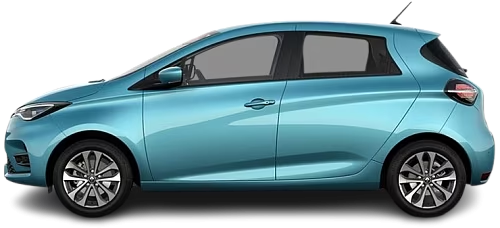USA EV Comparison: Nissan Leaf 60 kWh vs Renault Zoe Z.E. 50 R135
Struggling to Decide? Let AI Help!
Your AI Summary Is Ready!
General Info
Since both vehicles have been discontinued, they are now only available on the used car market. You can get the Nissan Leaf 60 kWh (2022-2025) for as low as $11467, while the Renault Zoe Z.E. 50 R135 (2019-2024) was never offered for sale in the United States.
The two vehicles share the same body style: Hatchback.
| Property | Nissan Leaf 60 kWh | Renault Zoe Z.E. 50 R135 |
|---|---|---|
| Years of Production | 2022-2025 | 2019-2024 |
| Current Status | Discontinued | Discontinued |
| Country of Manufacture | Japan, UK, USA | France |
| Body Style | Hatchback | Hatchback |
| Market Availability | EU, USA | EU |
| Price USA (Used) | $11467 | - Price USA (Used) |
| GCC Score | 5 | 5.6 |
Range and Efficiency
While the Nissan Leaf 60 kWh (2022-2025) offers a longer real-world range and a bigger battery, it is less energy-efficient than the Renault Zoe Z.E. 50 R135 (2019-2024).
| Property | Nissan Leaf 60 kWh | Renault Zoe Z.E. 50 R135 |
|---|---|---|
| Range (EPA) | 212 mi | - Range (EPA) |
| Range (WLTP) | 247 mi | 239 mi |
| Range (GCC) | 209 mi | 203 mi |
| Battery Capacity (Nominal) | 60 kWh | 54.7 kWh |
| Battery Capacity (Usable) | 59 kWh | 52 kWh |
| Efficiency per 100 mi | 28.2 kWh/100 mi | 25.6 kWh/100 mi |
| Efficiency per kWh | 3.54 mi/kWh | 3.9 mi/kWh |
| Range and Efficiency Score | 6 | 6.5 |
Charging
Both vehicles utilize a standard 400-volt architecture.
The Nissan Leaf 60 kWh (2022-2025) offers faster charging speeds at DC stations, reaching up to 100 kW, while the Renault Zoe Z.E. 50 R135 (2019-2024) maxes out at 50 kW.
The Renault Zoe Z.E. 50 R135 (2019-2024) features a more powerful on-board charger, supporting a maximum AC charging power of 22 kW, whereas the Nissan Leaf 60 kWh (2022-2025) is limited to 6.6 kW.
| Property | Nissan Leaf 60 kWh | Renault Zoe Z.E. 50 R135 |
|---|---|---|
| Max Charging Power (AC) | 6.6 kW | 22 kW |
| Max Charging Power (DC) | 100 kW | 50 kW |
| Architecture | 400 V | 400 V |
| Charge Port | CHAdeMO | CCS Type 2 |
| Charging Score | 3.8 | 6.9 |
Performance
Both vehicles are front-wheel drive.
The Nissan Leaf 60 kWh (2022-2025) boasts greater motor power and accelerates faster from 0 to 60 mph.
| Property | Nissan Leaf 60 kWh | Renault Zoe Z.E. 50 R135 |
|---|---|---|
| Drive Type | FWD | FWD |
| Motor Type | PMSM | EESM |
| Motor Power (kW) | 160 kW | 100 kW |
| Motor Power (hp) | 215 hp | 134 hp |
| Motor Torque | 251 lb-ft | 181 lb-ft |
| 0-60 mph | 6.8 s | 9.1 s |
| Top Speed | 106 mph | 87 mph |
| Performance Score | 3.7 | 2.5 |
Dimensions
The Nissan Leaf 60 kWh (2022-2025) is longer, but has a similar width and height to the Renault Zoe Z.E. 50 R135 (2019-2024).
The Nissan Leaf 60 kWh (2022-2025) boasts a more extended wheelbase.
| Property | Nissan Leaf 60 kWh | Renault Zoe Z.E. 50 R135 |
|---|---|---|
| Length | 176.4 in | 160.9 in |
| Width (with Mirrors) | 79.9 in | 76.6 in |
| Width (w/o Mirrors) | 70.5 in | 70.4 in |
| Height | 61.7 in | 61.5 in |
| Wheelbase | 106.3 in | 101.9 in |
Cargo and Towing
The Nissan Leaf 60 kWh (2022-2025) features a larger trunk, but the Renault Zoe Z.E. 50 R135 (2019-2024) offers greater maximum cargo capacity when the rear seats are folded.
Neither car is equipped with a frunk (front trunk).
Neither vehicle is officially rated for towing in the US.
| Property | Nissan Leaf 60 kWh | Renault Zoe Z.E. 50 R135 |
|---|---|---|
| Number of Seats | 5 | 5 |
| Curb Weight | 3901 lb | 3477 lb |
| Cargo Volume (Trunk) | 23.6 ft3 | 11.9 ft3 |
| Cargo Volume (Max) | 30 ft3 | 43.3 ft3 |
| Cargo Volume (Frunk) | - Cargo Volume (Frunk) | - Cargo Volume (Frunk) |
| Towing Capacity | - Towing Capacity | - Towing Capacity |
| Cargo and Towing Score | 4.6 | 4.2 |




